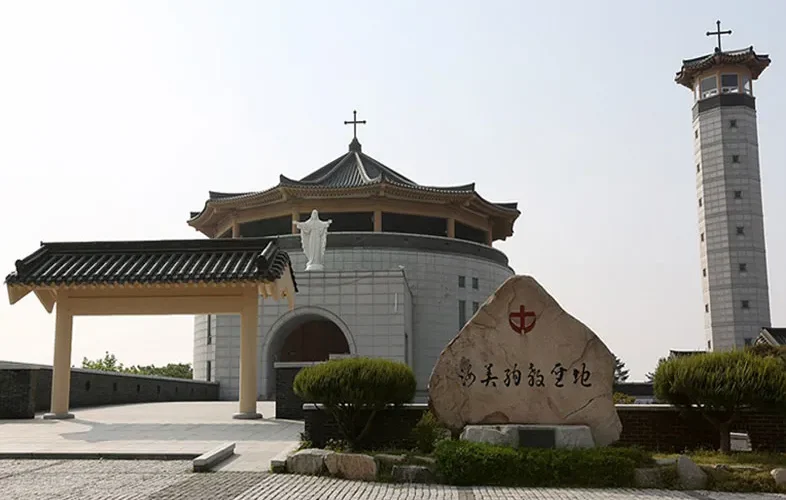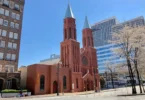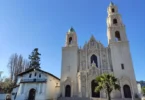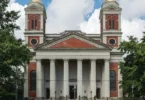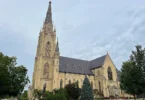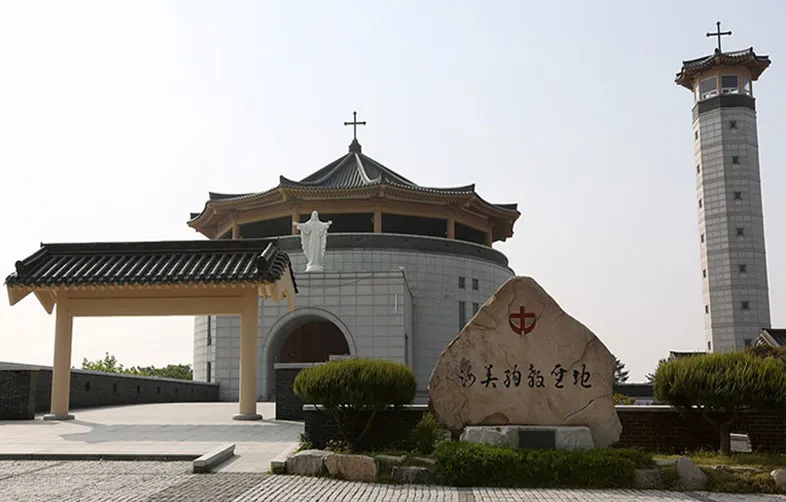
Introduction
The International Shrine of Haemi Martyrs is a significant religious site located in Seosan, South Korea. It commemorates the Christian martyrs who were persecuted during the Joseon Dynasty for their faith. The shrine stands as a symbol of resilience and faith for Christians in South Korea and beyond. Compared to already declared historical sites, places of apparitions of the Virgin Mary, and pilgrimage sites related to famous saints, this Haemije Shrine is unique.
There are no famous saints or special miracles, and there are not many people whose names or actions are recorded. Nevertheless, Haemi is a place where the body odors and traces of many martyrs, estimated to be over 1,000, remain, although no records were left behind. Although they were poor, they lived happily in God, dreaming of a new world, and the place where they willingly faced death and were buried is the Haemi International Shrine, the hometown of the unknown martyrs.
So, rather than being a land of sad history, this place can be said to be a place to meditate on the present of joy and life. The Catholic Church recognized the unknown martyrs, who were miserably buried alive without leaving a name, but would have received a name that shines brighter than any other in God’s kingdom, as exemplary examples of faith, and proudly announced this to the whole world, declaring the ‘Haemi International Shrine’ .
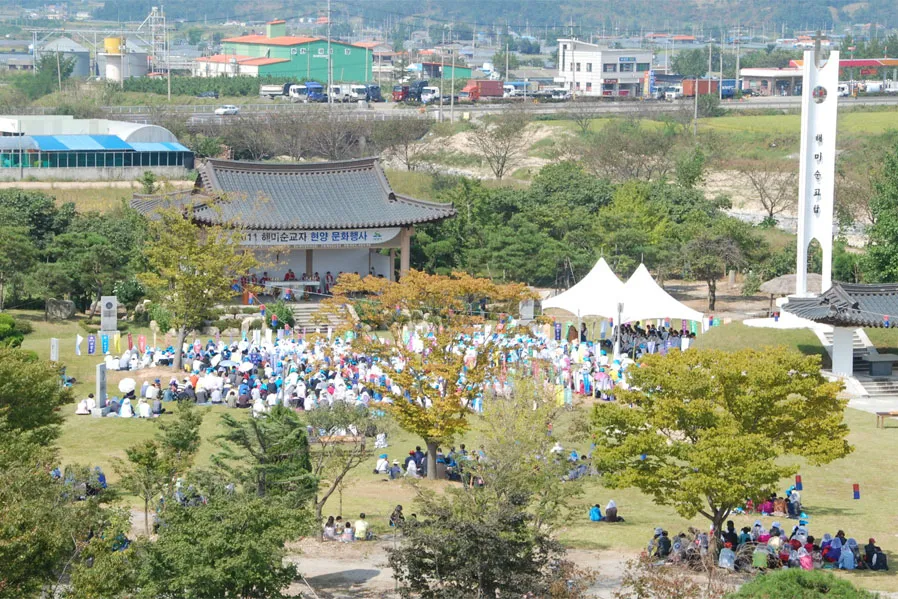
Haemi Shrine is a place where you can feel the traces of the cruel persecution more vividly than any other martyrdom site. Haemi, whose fierceness never dulled even once during the 100 years of persecution, has an incredible story of thousands of nameless martyrs being driven into puddles and pits and buried alive.
During this period of persecution, the two large prisons in the Haemi camp were filled with captured believers, and they were dragged out of the west gate every day to death by hanging, beheading, stoning, death by death, and death by death. In addition, an even more cruel method of lifting people up on stone bridges by their arms and legs and slamming them into stones was devised, and in some cases, several people were laid down and stone pillars were dropped to kill them all at once. It is said that if they found a body writhing and not breathing, they used a torch to close its eyes. Therefore, it is said that the outside of the west gate of Haemi Camp was always made up of the corpses of Catholic scholars, and the inside was made up of their blood.
Officials who were tired of executing people one by one, especially during the Great Persecution from Byeongin in 1866 to Mujin in 1868, buried them alive to make it easier to dispose of the bodies. The cruel act of dragging dozens of people to the western fields of Haemi’s camp, digging them up in random places, putting them alive in pits, and covering them with dirt and gravel was repeated countless times. There is no way to know exactly how many martyrs died like this or who died and how. However, out of the estimated thousands of martyrs, the names and places of origin of 132 people are still unclear, and the rest are unknown martyrs who did not leave a single name or letter. The historical site where they died is now cleanly maintained. The name ‘Yeosutgol’ has been passed down through the mouths of residents who recognized the prayers of believers singing “Jesus and Mary” as “Yeosumeori.”
In Haemi Eupseong, where the martyrs were tortured and executed, there is a prison site where the believers were imprisoned, and next to it there remains a hoya tree that was used as a torture table. Martyrs with their hair tied on top of this tree were hung and subjected to severe torture. At the martyrdom site outside the west gate, the Jarigae Stone Bridge, which was moved to Seosan Cathedral in 1956 and preserved, was restored to its original location in 1986, and was moved to Yeosutgol in January 2009 for preservation.
In 1935, the remains and relics of the martyrs were excavated by Father Peter Beom of the Seosan Parish and temporarily buried in the Sanghong-ri Public Office, 30 ri away. Recently, on the Martyrs’ Day in 1995, they were moved to the original site of martyrdom, buried alive, in front of the Martyrs’ Tower. Another sacred site that cannot be missed in the Haemi Shrine is the Hanti Pass. This pass was a notorious road to death at the time and was a transport route for martyrs, and is recorded in Dahle’s “History of the Catholic Church in Korea.” Although it is a single road, the pressure road marker ribbon is clearly visible, so you can make the pilgrimage without any difficulties.
The Haemi Shrine is well-connected to all four directions, so although it is a bit far away, it is perfect for a one-day or two-day pilgrimage. Nearby are Deoksan Provincial Park, famous for Sudeoksa Temple, Gayasan Mountain, Deoksan Hot Springs, Taean Coastal National Park, and Anmyeondo Island, where you can see the miracle of the ocean splitting, making it a place where you can enjoy the essence of a weekend family pilgrimage course.
Architecture of Haemi International Catholic Martyr's
The Haemi International Catholic Martyrs’ Shrine, located in Haemi, South Korea, is an architectural marvel that combines traditional Korean architectural elements with Catholic symbolism. The shrine features a blend of Korean hanok (traditional Korean house) architecture and Catholic church design. One of the most striking features of the shrine is its main hall, which resembles a traditional Korean pavilion with a curved, tiled roof. The use of natural materials such as wood and stone in construction adds to its traditional aesthetic.
Inside the shrine, visitors can find beautiful stained glass windows depicting scenes from the lives of the Korean Catholic martyrs. The architecture and interior design create a serene and contemplative atmosphere, conducive to prayer and reflection. Overall, the Haemi International Catholic Martyrs’ Shrine is not only a religious site but also a cultural landmark that showcases the rich heritage of both Korean architecture and Catholicism in South Korea
The interior of the Haemi International Catholic Martyrs’ Shrine in South Korea is designed to be both aesthetically beautiful and spiritually significant. Here are some key features commonly found inside the shrine:
1. Altar: The focal point of the interior is the altar, where religious services and rituals take place. The altar is often adorned with intricate carvings, religious symbols, and candles.
2. Stained Glass Windows: Many Catholic churches and shrines feature stained glass windows depicting religious scenes or figures. These colorful windows serve to inspire awe and contemplation among worshippers.
3. Icons and Statues: Icons and statues of Jesus, Mary, and various saints are often found throughout the interior of the shrine. These religious images serve as focal points for prayer and meditation.
4. Stations of the Cross: The Stations of the Cross, depicting the events of Jesus’ crucifixion, are commonly displayed along the walls of Catholic churches and shrines. Pilgrims may walk the stations as part of their devotional practice.
5. Pews: Seating arrangements in the form of pews provide worshippers with a place to sit during religious services. The pews are often arranged facing the altar to facilitate participation in worship.
6. Chapels and Prayer Rooms: Larger shrines may include chapels or prayer rooms dedicated to specific saints or devotional practices. These spaces offer worshippers a quiet place for personal prayer and reflection.
7. Decorative Elements: Decorative elements such as paintings, tapestries, and liturgical furnishings contribute to the overall ambiance of the interior. These elements may feature religious motifs or symbols significant to the Catholic faith.
Overall, the interior of the Haemi International Catholic Martyrs’ Shrine is designed to facilitate worship, prayer, and spiritual contemplation for visitors of all backgrounds.
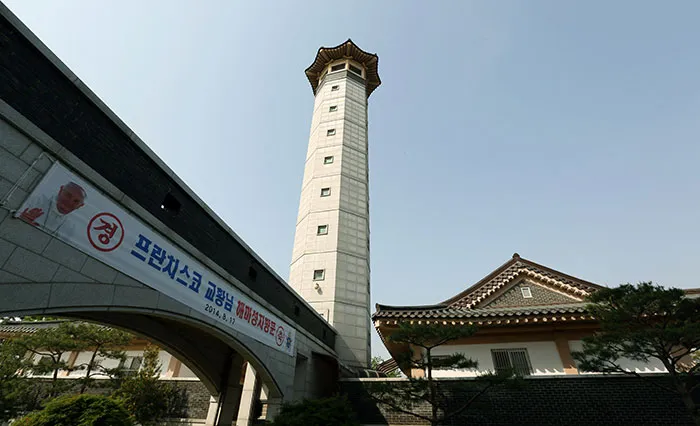
Holy site composition
It was built on the site of the 8,903m Shrine of the Unknown Martyr located in Haemi. In the shrine, a cathedral with 700 seats and a minor cathedral with 200 seats were built with 4 floors above ground and a total area of 3,234m . The memorial hall located behind the cathedral was built in the shape of a martyr’s tomb. Inside the memorial hall, paintings and murals documenting martyrdom are installed, and the excavated remains of martyrs are enshrined. He also built an octagonal tower symbolizing a watchtower, a rectory, and a convent.
In addition, ‘Jindumbeong’, where believers were tied up and drowned by dropping them into a puddle of water, the 16m high ‘Haemi Martyrdom Tower’ to commemorate the unknown martyrs who were buried alive next to Haemi Stream, the Tomb of the Unknown Martyr, the open-air cathedral built at the site of the remains excavated, and Haemi-eup There is a rough stone for the martyr site outside the west gate of the castle.
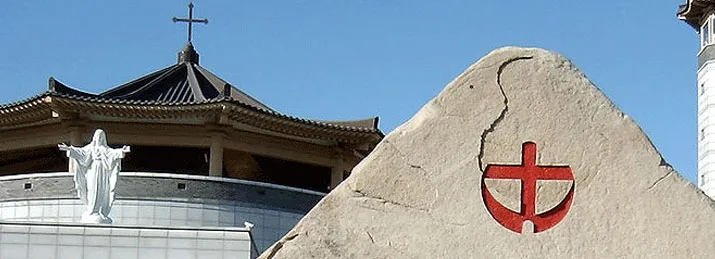
South Korea: Haemi Shrine Erected as an International Pilgrimage Site
The field of martyrs of Haemi, South Korea, has become the second Korean site to be established as an international pilgrimage site by the Vatican, thus joining such high places of Christian spirituality as Jerusalem, Rome, and Santiago de Compostela. The Haemi Shrine is located in Seosan Municipality, South Chungcheong Province, about 280 kilometers south of the capital Seoul. Pope Francis visited there on August 17, 2014 during his trip to South Korea.
It was there between 1866 and 1882, during the reign of the emperors from the Joseon Dynasty, that two thousand Catholics were imprisoned, tortured, and buried alive in hatred of the Faith. March 1, 2021 was a day of rejoicing in the Diocese of Daejon. That morning, Bishop Lazzaro You Heung-sik announced that the Holy See had just established Haemi as an international pilgrimage site.
An announcement that fell on the same day the Korean Catholic Church celebrated the bicentennial of the birth of Fr. Thomas Choe Yang-eop. This priest, born on March 1, 1821, a figure in the South Korean Catholic clergy, is revered for relentlessly traversing his country, plagued by persecution, in order to administer the sacraments secretly to the faithful, until he contracted typhoid fever which would cause his death in 1861.
Thanks to the efforts of the local church, a 16-meter-high monument has been erected on the site of Haemi’s future international pilgrimage site, to honor the memory of hundreds of martyrs, most of whom remain unknown to this day. “The establishment of the Haemi Martyrs’ Camp as an official international pilgrimage site is a glorious event that expresses the recognition of the heroic faith of so many anonymous martyrs, setting an example to the world,” the rector of Haemi Shrine stated in an interview with Yonhap News Agency.
On the Vatican side, Msgr. Salvatore Fisichella, president of the Pontifical Council for the Promotion of the New Evangelization, insisted that the testimony of the many Korean martyrs “passed on the faith to their descendants and thus founded the living community of disciples and witnesses of Jesus Christ.” But the apostolate is still immense in South Korea: out of 51.8 million inhabitants, only 5.6 million belong to the Catholic Church, or 11% of the population, while 46% declare themselves to be without religion, 23% as Buddhist, and 18% as Protestant.
Martyrdom and creation of a shrine
The captured Catholics were imprisoned in two prisons in Haemieupseong Fortress and then executed. Data on those executed include 67 church records, 65 observation records, and 47 people recorded as unknown martyrs, but it is presumed that the number of other unknown martyrs is countless. In Haemi Jinyoung’s independent action, people who were likely to be subject to censure after his death were transferred to higher-ranking towns such as Hongju (Hongseong) and Gongju, and the fact of transfer and the names of those transferred are said to be left in the records. Most of those executed in Haemieupseong Fortress or Yeosutgol were commoners who could not be transported to Hongseong or Gongju, so they were killed indiscriminately without any hearing or recording procedures. In addition, after the Byeonginyangyo in October 1866, the order to execute first and then report to the government was issued, so Catholic believers could be arbitrarily executed in the Haemi camp. The officials who carried out the executions were so annoying that they omitted to report them to the government or did not leave any records. Therefore, it is assumed that there are more nameless martyrs.
In the early days, executions were carried out one by one outside the west gate of Haemieupseong Fortress using methods such as hanging, beheading, bludgeoning, stoning, death by death, and death by death. Then a more cruel method was devised. After lifting the prisoner’s body on a stone bridge, he struck a sheaf of grain and struck it like threshing, breaking his head and causing him to die. The stone used at this time was named ‘Jarigaetdol’, which is 4.2m long and 1.5m wide, and is still preserved and displayed outside the west gate. Catholics were tortured or hanged by hanging them from an old locust tree with wire rope. It is said that several people were laid down and stone pillars were dropped to kill them all at once, and if there was a body that was squirming, a torch was used to burn its eyes. Therefore, it is always recorded that outside the west gate of the Haemi camp, a mountain was formed with the corpses of Catholic sinners and the temple was built with their blood.
During the Great Persecution from Byeongin Year in 1866 to Mujin Year in 1868, as the number of people increased, they began to bury the bodies alive to simplify disposal.They dragged dozens of people out to the western field of Haemi’s camp, found a good place to dig, made a big hole, pushed the survivors in, and buried them with dirt and gravel. It is said that before the church designated this place as a martyrdom site, there were many discarded bones caught on the ends of the tools of farmers who farmed here. It is said that the bones dug up at this time were found standing vertically, which can be said to be evidence that they were buried alive. Additionally, as live burial was implemented, when the number of criminals was small in the summer, the commanders ordered them to be buried to save on the inconvenience. Criminals were tied up tightly in a ditch in the middle of a stream and drowned to death. It was called ‘Convict Doombeong’ because it was a ditch where Catholic prisoners were drowned and killed, but now even the name has changed and is called ‘Jindumbeong’.
Excavation of remains
In 1935, 『Kyunghyang Magazine』, which could be considered an organ of the Catholic Church at the time, introduced testimonies about Hae-mi’s martyrdom seven times. As a result, Haemi Shrine became widely known. Additionally, Father Bumbaro and Catholic believers in the Seosan region began excavating the remains based on the testimony of eyewitnesses. At the excavation site, the rotten dirt of dozens of bodies was identified, and the remains of about 10 of them were found. Father Bumbaro temporarily buried the remains and belongings of the martyrs at Sanghong-ri Public Complex, 30 ri away, and it was not until 1995 that they were moved back to this place, the excavation site for the remains. However, it is said that many of the remains were lost in the flood. The remaining remains are preserved and placed separately. Additionally, Father Bumbaro, who took the lead in excavating the remains, died at the young age of 43 on January 13, 1946.
Religious meaning of martyrdom
Losing one’s life to protect one’s faith in the Roman Catholic Church is called ‘martyrdom.’ Martyrdom in the Catholic Church means that those who have experienced the mercy and love of God , the object of devotion, sacrifice their lives as evidence of their faith. This is expressed as ‘martyrdom piety.’ The martyrdom at the site of the Haemije Shrine contributed to the formation of this spirit of martyrdom and devotion in the history of the Roman Catholic Church in Korea . In addition, the visit of Pope Francis and the beatification of the three Haemi martyrs encourage believers in this world to learn about the lives and faith of the Haemi martyrs.
Haemi International Shrine
Compared to already declared historical sites, places of apparitions of the Virgin Mary, and pilgrimage sites related to famous saints, this Haemije Shrine is unique. There are no famous saints or special miracles, and there are not many people whose names or actions are recorded. Nevertheless, Haemi is a place where the body odors and traces of many martyrs, estimated to be over 1,000, remain, although no records were left behind. Although they were poor, they lived happily in God, dreaming of a new world, and the place where they willingly faced death and were buried is the Haemi International Shrine, the hometown of the unknown martyrs. So, rather than being a land of sad history, this place can be said to be a place to meditate on the present of joy and life.
The Catholic Church recognized the unknown martyrs, who were miserably buried alive without leaving a name, but would have received a name that shines brighter than any other in God’s kingdom, as exemplary examples of faith, and proudly announced this to the whole world, declaring the ‘Haemi International Shrine’
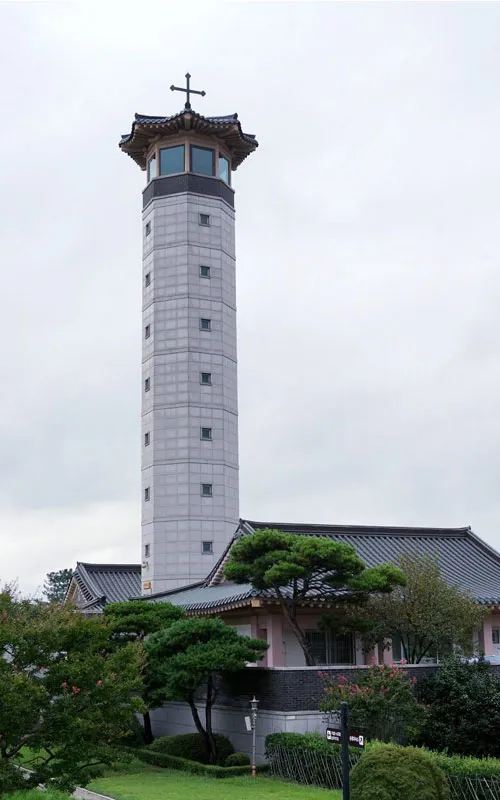
Annual Feast Day
Feast day: 20 September
The annual feast day of Haemi International Catholic Martyr’s Shrine, South Korea is celebrated on September 20 each year.
Mass Timing
It is offered at 11 a.m. every day from Monday to Sunday .
Confession 10 am
Contact Info
13 Seongji 1-ro,
Haemi-myeon,
Seosan-si,
Chungcheongnam-do,
South Korea.
Phone No.
Phone: +041-688-3183
Accommodations
Connectivities
Airway
The nearest airport to the Church of Haemi International Catholic Martyr’s Shrine is, Incheon International Airport which is just 4 hrs 23 min (83.3 km) away from the basilica.
Railway
The nearest railway to the Church of Haemi International Catholic Martyr’s Shrine, Pyeongtaek station, Pyeongtaek which is just 3 hrs 43 min (57.6 km) away from the basilica.

